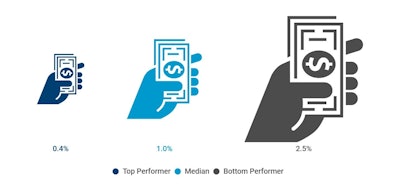
Despite the establishment of a formal procurement process, some organizations have staff members who engage in maverick purchasing—the bypassing of standard procedures to procure items individually. Maverick purchasing often occurs because a staff member views the established procurement process as too complicated or a waste of time. According to APQC’s Open Standards Benchmarking in procurement for organizations with at least $500 million in annual revenue, in bottom-performing organizations maverick purchasing represents 2.5 percent or more of their total purchases (see Figure 1). This may not seem like a large amount, but for an organization with $1 billion in annual purchases, 2.5 percent represents $25 million, which is a significant amount.
To determine how maverick purchasing can affect an organization’s procurement function, APQC looked at its Open Standards Benchmarking data from two groups with at least $500 million in revenue: those with less than 1 percent of their purchases obtained via maverick purchasing and those with 2 percent or more of their purchases procured via maverick purchasing. The results of the analysis indicate that order placement time and overall procurement cost all improve with less maverick spending.
Effects On Cycle Time
APQC’s data reveals that, despite the common belief that maverick buying enables employees to obtain materials faster, this purchasing method may result in slower order processing. At the median, organizations with higher levels of maverick purchasing need 16 hours more to issue a purchase order to a vendor (see Figure 2).
The faster time to place a purchase order for organizations with less maverick purchasing could be the result of those organizations having more streamlined and regulated purchasing processes. In particular, they often have stricter procurement processes and systems that ensure adherence to processes and reduce the opportunity for maverick buying. Standardized and enforced processes can result in a purchase order being issued to a vendor more quickly.
Organizations with less maverick purchasing are also more likely to use vendors that have been vetted and approved. This typically means that procurement staff has a relationship with the vendor and established processes to quickly issue purchase orders to that vendor. The use of approved vendors also means that organizations have already determined the reliability of those vendors, which can lead to faster and more complete deliveries.
Effects on Procurement Cost
APQC’s data also indicates that organizations with more maverick purchasing spend more on the procurement process overall (see Figure 3). At the median, there is a $2.58 difference in the cost of procurement per $1,000 in purchases between organizations with 2 percent or more of their purchases made via maverick buying and organizations with less than 1 percent. For an organization with $1 billion in purchases annually, this represents a difference of more than $2.5 million dollars in procurement spending.
The lower procurement cost incurred by organizations with less maverick buying is likely related to the fact that these companies need fewer full-time equivalent employees (FTEs) in procurement. It makes sense that if more employees follow the process or if the process is driven by a system that requires compliance, then procurement professionals are spending less time chasing down rogue or maverick purchases that do not comply with the documented processes.
Take a Comprehensive Approach
APQC’s research shows that, contrary to what some employees may believe, maverick purchasing does not necessarily result in faster or cheaper purchasing. Organizations should take a comprehensive approach to formalizing procurement processes and reducing maverick buying. They should adopt procurement methods so that it is not feasible for employees to order products or services without following established channels. Electronic purchase order approval can be built into systems to ensure that appropriate vendors are used and that purchases are obtained at a reasonable price. Employee training and better communication within the organization regarding the importance of adhering to procurement processes can also reduce the incidence of maverick purchasing.
At the same time, organizations must consider whether their procurement processes are too complex. They must also evaluate whether or not employees have received adequate training on procurement procedures. If adequate training has not been provided, or if the processes are not user-friendly, employees will bypass formal procedures to get what they need. Organizations must consider all factors that can lead to increased maverick purchasing. They need to take steps to address these factors so that procurement can continue to provide value to the enterprise beyond the bottom line.













